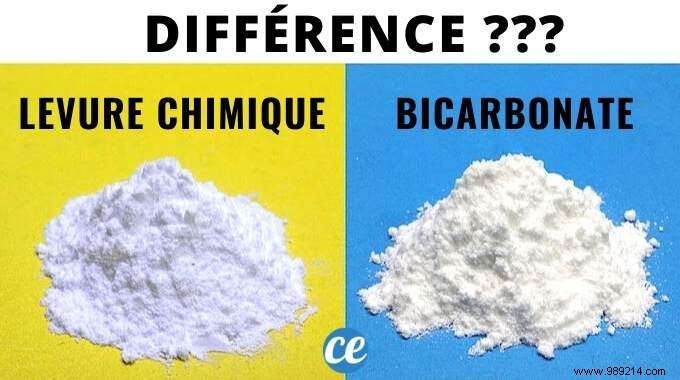
What is the difference between baking soda and baking powder?
These 2 products come in the form of a white powder.
And both serve to swell the dough to give an airy texture and that magnificent softness so appreciated in pastry recipes.
It is surely because of these similarities that pastry chefs, both amateur and experienced, tend to confuse these 2 leavening agents!
Luckily, we've listed all the differences between baking soda and baking powder . Watch:
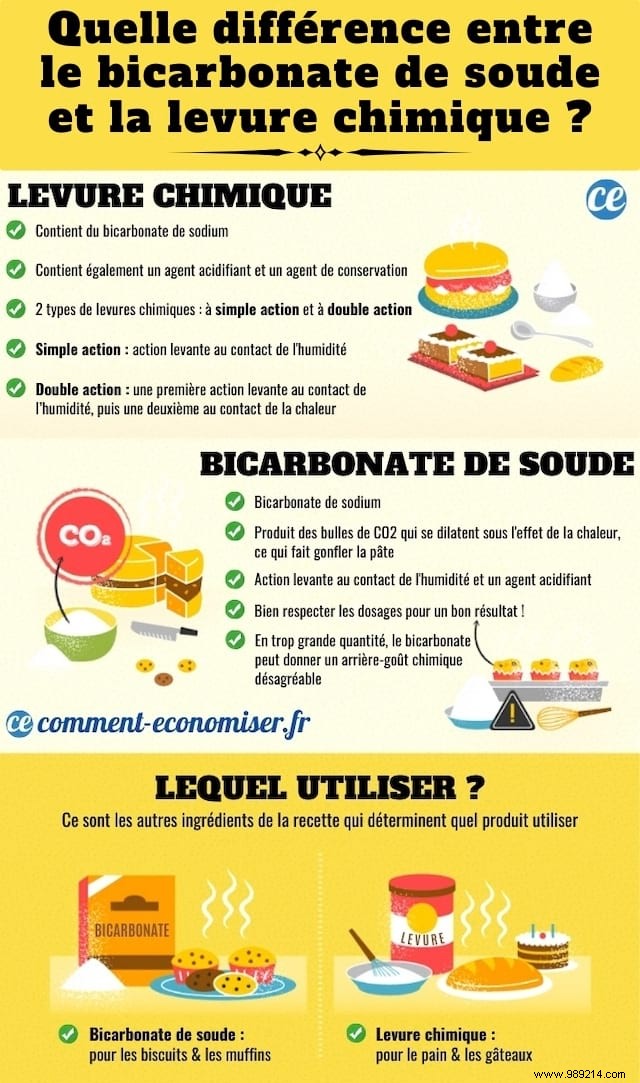
Click here to easily print this guide in PDF.
But that's not all...
We will also show you how to replace baking soda with baking powder (and vice versa) in your baking recipes.
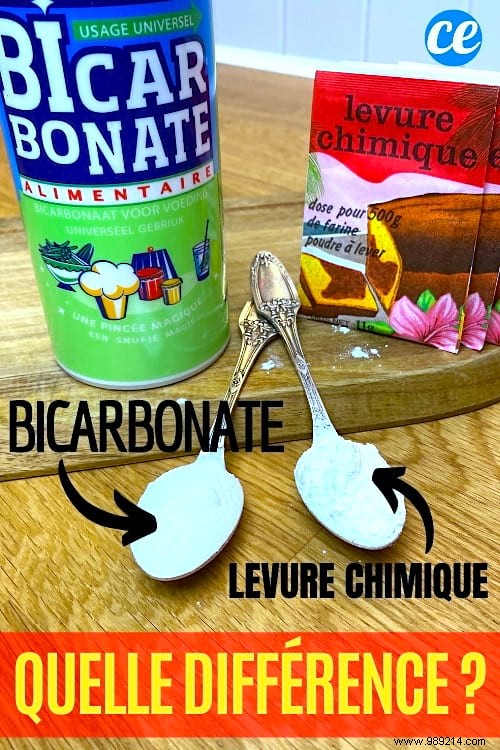
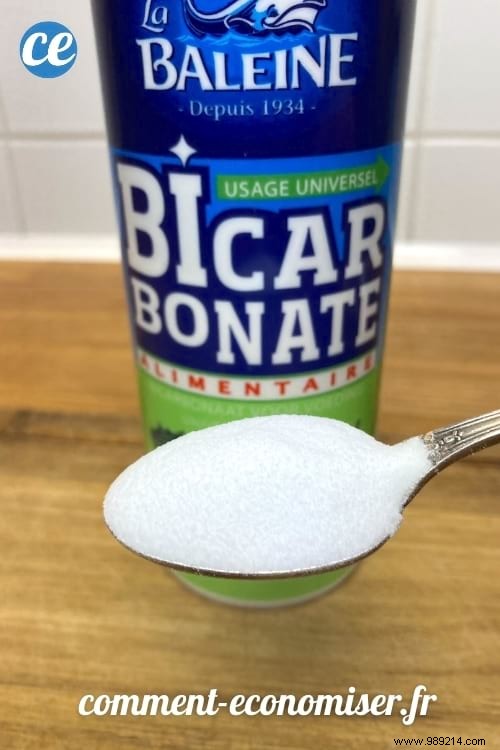
Baking soda is a leavening agent used to raise the dough of pastries and pastries (cakes, muffins, cookies).
Also known by the scientific name of sodium bicarbonate, it comes in the form of a white powder.
Bicarbonate is naturally basic, that is, it is non-acidic.
When you mix baking soda with a liquid and an acidic substance , this causes a chemical reaction.
This reaction produces bubbles of carbon dioxide, which expand as the temperature increases.
And, as you might have guessed, it is precisely this reaction that causes the dough of your pastries to rise.
As the carbon dioxide bubbles expand, they give your cakes, cookies and other pastries a delicious, airy, fluffy texture.
So when a recipe calls for baking soda (base ), it must necessarily include an ingredient acid .
It is for this reason that recipes with baking soda also contain an acidifying agent.
It can be yogurt, lemon juice, milk, buttermilk, brown sugar, apple cider vinegar, cream of tartar, applesauce, cocoa powder, honey, etc.
In summary:
Mixing baking soda with a liquid and an acidic ingredient causes a chemical reaction that causes the pastry dough to rise.
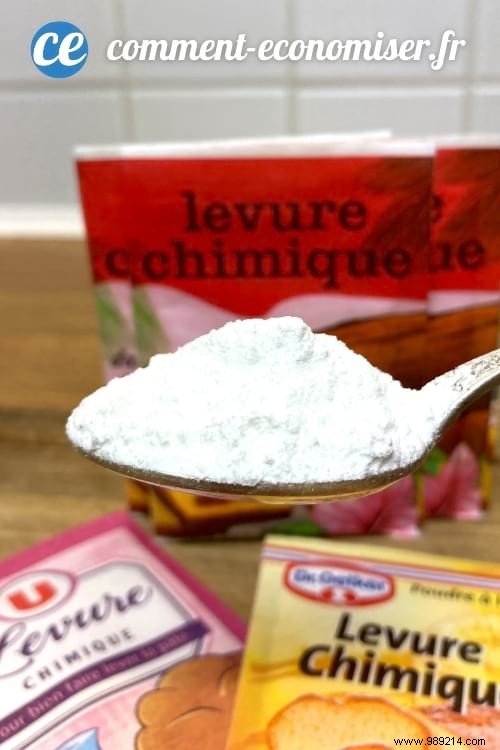
Baking powder is a leavening agent in its own right.
This means that it contains both the base (bicarbonate) and the acidifying agent necessary for the chemical reaction that causes pastries to rise.
Thus, it acts alone:no need to add an acidic ingredient .
Typically, baking powder also contains a preservative.
Most often it is a starch (corn or wheat starch) which serves to absorb moisture and prevent the activation of the chemical reaction.
Along with the baking soda, you must add a liquid and an acidic substance to activate the famous carbon dioxide bubbles and make the dough rise.
With baking powder, which already contains baking soda and an acidifying agent, you get exactly the same reaction by just adding moisture.
Know that there are 2 types of baking powder:single action and double action.
Single action yeast is primarily used by food manufacturers, and is not generally intended for home use.
Most commercial baking powders these days are dual action yeasts.
This means that the rising of the dough is done in two separate reactions.
The first lift battering occurs when baking powder is mixed with a liquid at room temperature, such as when you need to mix the dry and wet ingredients in a recipe.
This is why, in some recipes, you cannot prepare the dough in advance and bake it later:because the baking powder has already been activated.
The second lift happens when the temperature rises, like when you put your cake in the oven.
But then, what advantage?
For most recipes, this long-acting reaction allows the dough to gradually rise, instead of rising all at once.
In summary:
Baking powder contains both a base (bicarbonate) and an acidifying agent, making it a leavening agent in its own right.
It comes in two forms, single action and double action, the latter being the most commonly used.
To discover: 22 Amazing Uses of Baking Powder Nobody Knows About.
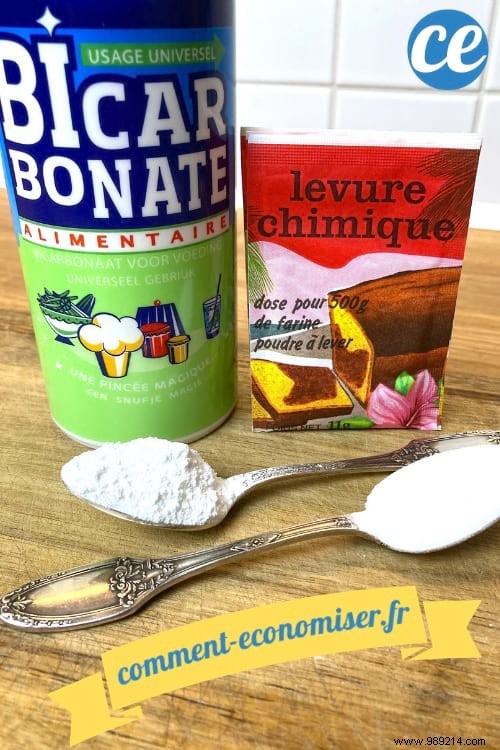
Baking soda is used in recipes that contain an acidic ingredient, such as yogurt, lemon juice, or buttermilk.
On the contrary, recipes that call for baking powder do not contain acidic ingredients.
Indeed, the baking powder already contains the acidifying agent necessary for the production of carbon dioxide bubbles.
Be aware that the level of acidity in baking preparations can vary considerably.
Thus, to obtain a pleasant texture and a tasty taste, it is necessary to find the right balance between acid and base .
Warning, we tend to believe that by adding more yeast, the dough will rise more... On the contrary, this is a mistake!
Plus, it will give it an unpleasant yeasty aftertaste. So, respect the dosage of your recipes!
Likewise, be careful not to overdose the baking soda.
In too large quantities, it can give a bitter and chemical taste to your preparations.
Note also that some recipes call for both baking soda AND baking powder.
In general, these are recipes that contain an acidic ingredient and baking soda, but not enough to make the preparation rise.
In summary
Baking soda is used in recipes that contain an acidic ingredient, while baking powder can be used in recipes without an acidic ingredient
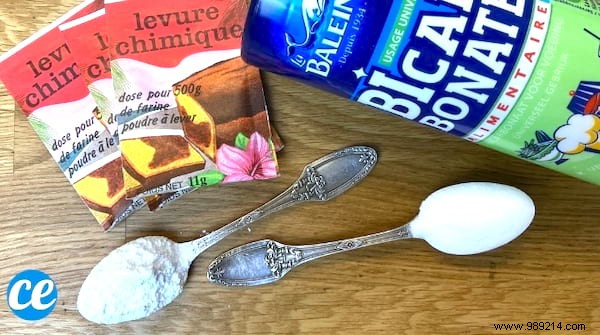
Yes, it is possible to replace baking soda with baking powder, and vice versa.
But it's not as simple as that...
Not recommended, but…
In a kitchen emergency, this can work, especially when you don't have baking soda on hand.
When you use baking powder to replace baking soda, there is no need to add other ingredients.
However, baking powder is much less potent than baking soda.
So, to get the same leavening action, you need about 3 times more baking powder than baking soda.
On the other hand, be aware that this replacement can alter the taste of your preparations, in particular by causing bitterness and a "chemical" taste.

Your recipe calls for baking powder, but you only have baking soda on hand?
If you have understood how they work, you know that you can replace baking powder with bicarbonate.
Unlike baking powder, baking soda has no acidifying agent.
Thus, to activate the bicarbonate reaction, you will also have to add an acidic ingredient, such as cream of tartar.
In addition, baking soda is much more powerful than baking powder.
As a general rule, use about 1/4 teaspoon baking soda to replace 1 teaspoon of baking powder .
And again, watch out!
If you overdose the amount of baking soda in your recipe, that doesn't necessarily mean that your preparation will rise even more.
Indeed, it is a question of balance:if you put too much bicarbonate and not enough acid, part of the bicarbonate will not be activated.
Therefore, it will leave a metallic and soapy taste in your baked goods. Yuck!
In summary
Substituting baking powder and baking soda in your recipes isn't easy. But by carefully changing the dosages, it can work.
To discover: How and What to Replace Baking Powder?
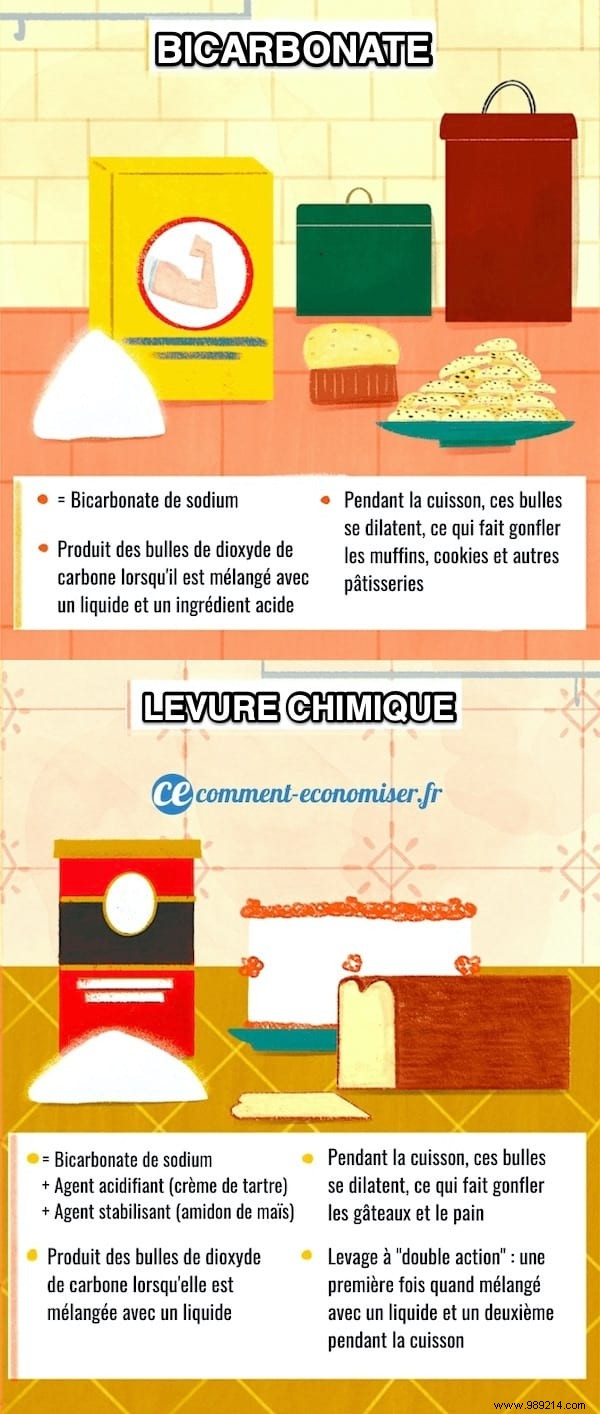
Click here to easily print this guide in PDF.
In baking, baking soda or baking powder is often used to raise the dough.
Some recipes even call for both ingredients at the same time.
Yet, even though baking soda and baking powder look alike, they are far from the same.
To activate the chemical reaction that causes pastries to rise, baking soda requires the addition of a liquid and an acidic substance.
As for baking powder, it already contains baking soda and an acidifying agent.
So, to activate it, you just have to mix it with a liquid.
It is possible to substitute bicarbonate for yeast, and vice versa, by modifying the dosage and adding acidic ingredients if necessary.
And know that if you have expired baking powder, you can still use it thanks to these tips here.